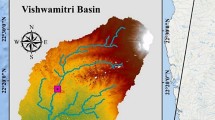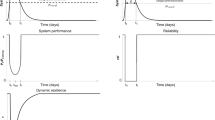Abstract
In this paper, by using the concept of Conditional Value at Risk (CVaR), a Leader-Follower game (LFG) based multi-objective optimization model is developed to determine the optimum 12-month operation policy of a reservoir in potential future dry periods. The minimization of CVaRs of storage loss and agricultural and environmental deficits along with maximization of planned allocation to agricultural sector are considered as leader’s objectives, while the followers try to maximize their share of water rights using Nash bargaining (NB) method. This framework is then used to model the operation policy of Dorudzan basin in Fars province, southwestern Iran. Water demand and daily climate data in the period of 2003 to 2015 for this basin, as well as future projections from fifteen IPCC-AR4 global circulation models (GCMs) for 2018–2030 under A2, B1 and A1B emission scenarios are considered to evaluate future dam operation policies. Future projections are downscaled using the LARS-WG model, which then feeds the HMETS watershed model to simulate the corresponding reservoir inflow time-series. Thereafter, three-hundred 12-month rainfall, evaporation and inflow time series with least inflow volume are used as input for the optimization model, which is solved using NSGA-II and GA algorithms. The results show while the model can determine the operation policy that keeps the associated risks in the acceptable range, it can satisfy the followers demands with respect to the available resources. The results also show that the agricultural sector of the study area can be hugely affected by potential future droughts.





Similar content being viewed by others
References
AghaKouchak A, Feldman D, Hoerling M, Huxman T, Lund J (2015) Water and climate: recognize anthropogenic drought. Nature 524(7566):409–411. https://doi.org/10.1038/524409a
Benchekroun H, Long NV (2001) Leader and follower: a differential game model. Cirano, Montreal
Chang FJ, Wang KW (2013) A systematical water allocation scheme for drought mitigation. J Hydrol 507:124–133
Chen Y, He L, Lu H, Li J, Ren L (2017) A leader-follower-interactive method for regional water resources management with considering multiple water demands and eco-environmental constraints. J Hydrol 548:121–134
Claessens S, Kreuser J (2004) A framework for strategic foreign reserves risk management. Risk Management for Central Bank Foreign Reserves. European Central Bank Publication, Frankfurt am Main, pp 47–73
Curiel IJ, Maschler M, Tijs SH (1987) Bankruptcy games. Z Op Res 31(5):A143–A159
Deb K, Agrawal S, Pratap A, Meyarivan T (2000) A fast elitist non-dominated sorting genetic algorithm for multi-objective optimization: NSGA-II. International Conference on Parallel Problem Solving From Nature, Springer, Berlin, pp 849–858
Deb K, Agrawal S, Pratap A, Meyarivan T (2002) A fast and elitist multi-objective genetic algorithm: NSGA-II. IEEE Trans Evol Comput 6(2):182–197
Frenken K, Gillet V (2012) Irrigation water requirement and water withdrawal by country. FAO, Rome
Goodarzi E, Lee TS, Ziaei M (2014) Risk and uncertainty analysis for dam overtopping-case study: the Dorudzan dam, Iran. J Hdro-environment Research 8:50–61. https://doi.org/10.1016/j.jher.2013.02.001
Graveline N (2016) Economic calibrated models for water allocation in agricultural production: a review. Environ Model Softw 81:12–25
Guo P, Huang GH (2009) Two-stage fuzzy chance-constrained programming: application to water resources management under dual uncertainties. Stoch Env Res Risk A 23(3):349–359
Gupton G, Finger C, Bhatia M (1997) Credit metrics, technical document. Morgan Guaranty Trust, New York
Haro D, Paredes J, Solera A, Andreu J (2012) A model for solving the optimal water allocation problem in river basins with network flow programming when introducing non-linearities. Water Resour Manag 26(14):4059–4071
Hirayama K, Kawai H, Tatano H (1996) A hybrid genetic algorithm for a single reservoir operation optimization model with multiple reliability constraints. In: Proceedings of the International Conference on Water Resources and Environmental Research, Kyoto, Japan, 2, 47–54
Holland JH (1992) Adaptation in natural and artificial systems: an introductory analysis with applications to biology, control, and artificial intelligence. MIT press
Hossain MS, El-shafie A (2013) Intelligent systems in optimizing reservoir operation policy: a review. Water Resour Manag 27(9):3387–3407
Khorshidi MS, Nikoo MR, Sadegh M (2018) Optimal and objective placement of sensors in water distribution systems using information theory. Water Res 143:218–228
Khorshidi MS, Nikoo MR, Ebrahimi E, Sadegh M (2019) A robust decision support leader-follower framework for Design of Contamination Warning System in water distribution network. J Clean Prod 214:666–673
Madani K (2014) Water management in Iran: what is causing the looming crisis? J Environ Stud Sci 4(4):315–328
Maqsood I, Huang GH, Yeomans JS (2005) An interval-parameter fuzzy two-stage stochastic program for water resources management under uncertainty. Eur J Oper Res 167(1):208–225
Martel JL, Demeester K, Brissette F, Poulin A, Arsenault R (2017) HMETS-A simple and efficient hydrology model for teaching hydrological modelling, flow forecasting and climate change impacts. Int J Eng Educ 33(4):1307–1316
Nandalal KDW, Simonovic SP (2002) State-of-the-art report on systems analysis methods for resolution of conflicts in water resources management. Department of Civil and Environmental Engineering, The University of Western Ontario, Ontario
Nash JF (1953) Two-person cooperative games. Econometrica. 21:128–140
Nikoo MR, Varjavand I, Kerachian R, Pirooz MD, Karimi A (2014) Multi-objective optimumA design of double-layer perforated-wall breakwaters: Application of NSGA-II and bargaining models. Applied Ocean Research 47:47–52
Raei E, Nikoo MR, Pourshahabi S (2017) A multi-objective simulation-optimization model for in-situ bioremediation of groundwater contamination: application of bargaining theory. J Hydrol 551:407–422
Rockafellar RT, Uryasev S (2000) Optimization of conditional value-at-risk. J Risk 2(3):21–41
Rockafellar RT, Uryasev S (2002) Conditional value-at-risk for general loss distributions. J Banking Finan 26(7):1443–1471
Sadegh M, Kerachian R (2011) Water resources allocation using solution concepts of fuzzy cooperative games: fuzzy least core and fuzzy weak least core. Water Resour Manag 25(10):2543–2573
Sadegh M, Mahjouri N, Kerachian R (2010) Optimal inter-basin water allocation using crisp and fuzzy Shapley games. Water Resour Manag 24(10):2291–2310
Safari N, Zarghami M, Szidarovszky F (2013) Nash bargaining and leader-follower models in water allocation: application to the Zarrinehrud river basin, Iran. Appl Math Model 38(7–8):1959–1968
Semenov MA, Barrow EM (2002) A stochastic weather generator for use in climate impact studies. User Man., Herts, UK
Sethi LN, Panda SN, Nayak MK (2006) Optimal crop planning and water resources allocation in a coastal groundwater basin, Orissa, India. Agric Water Manag 83(16):209–220
Singh DK, Jaiswal CS, Reddy KS, Singh RM, Bhandarkar DM (2001) Optimal cropping pattern in a canal command area. Agric Water Manag 50:1–8
Solomon S, Qin D, Manning M, Marquis M, Averyt K, Tignor M, Miller H, Chen Z (2007) Climate change 2007: the physical science basis. Contribution of working group I to the fourth assessment report of the intergovernmental panel on climate change. Cambridge University Press, Cambridge
Su MR, Yang ZF, Liu GY, Chen B (2011) Ecosystem health assessment and regulation for urban ecosystems: a case study of the Yangtze river delta urban cluster, China. J Environ Inf 18(2):65–74
Yoon K, Hwang CL (1981) TOPSIS (technique for order preference by similarity to ideal solution)—a multiple attribute decision making. In: Hwang CL, Yoon K (eds) Multiple attribute decision making—methods and application, a state-of-the-art survey. Lecture notes in economics and mathematical systems. Springer-Verlag, Berlin, pp 128–140
Zhang C, Guo P (2017) An inexact CVaR two-stage mixed-integer linear programming approach for agricultural water management under uncertainty considering ecological water requirement. Ecol Indic 92:342–353
Author information
Authors and Affiliations
Corresponding author
Ethics declarations
Conflict of Interest
The authors declare that they have no conflict of interest.
Additional information
Publisher’s Note
Springer Nature remains neutral with regard to jurisdictional claims in published maps and institutional affiliations.
Electronic supplementary material
ESM 1
(DOCX 374 kb)
Rights and permissions
About this article
Cite this article
Khorshidi, M.S., Nikoo, M.R., Sadegh, M. et al. A Multi-Objective Risk-Based Game Theoretic Approach to Reservoir Operation Policy in Potential Future Drought Condition. Water Resour Manage 33, 1999–2014 (2019). https://doi.org/10.1007/s11269-019-02223-w
Received:
Accepted:
Published:
Issue Date:
DOI: https://doi.org/10.1007/s11269-019-02223-w




